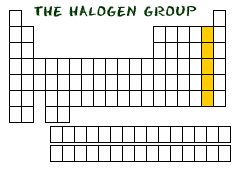Halogens on the Periodic Table In the second column from the right side of the periodic table, you will find Group Seventeen (Group XVII). This column is the home of the halogen family of elements. Who is in this family? The elements included are Fluorine (F), Chlorine (Cl), Bromine (Br), Iodine (I), and Astatine (At).

WHAT MAKES THEM SIMILAR?
When you look at our descriptions of the elements fluorine (F) and chlorine (Cl) you will see that they both have seven electrons in their outer shell. That seven-electron idea applies to all of the halogens. They are all just one electron shy of having full shells. Because they are so close to being happy, they have the trait of combining with many different elements. You will often find them bonding with metals and elements from Group One of the periodic table.
Sodium Chloride is a Halogen We've just told you how reactive they are. Not all halogens react with the same intensity. Fluorine is actually the most reactive and combines all of the time. As you move down the column, reactivity decreases. As you learn more about the table, you will find this pattern true for other families.
THEN WHAT IS A HALIDE?
The elements we are talking about in this section are called halogens. When a halogen combines with another element, the resulting compound is called a halide. One of the best examples of a halide is sodium chloride (NaCl). Don't think that the halogens always make ionic compounds. Many halides of the world are made with covalent compounds.
No comments:
Post a Comment